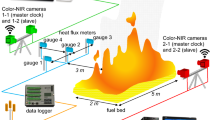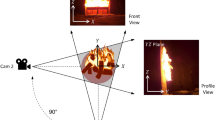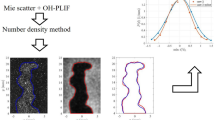Abstract
This paper demonstrates a simple method to enhance visibility through clean-burning flames that allows new opportunities to perform optical metrology in fire research. The method combines narrow-spectrum, blue illumination and matched optical filters to reduce the influence of optical emissions from a glowing hot target and a large natural gas diffusion flame. The paper describes how the required illumination strength and filtering can be estimated from basic combustion and optical principles. Compared to white light, the required illumination to detect objects engulfed in flames with this method is reduced by a factor of 104. A series of experiments are conducted to determine the effectiveness of this method, successfully demonstrating the ability to take images of objects in natural gas fires up to 1000 kW using 200 W of illumination power. These experiments corroborate the estimation of relative optical intensities, as it is observed that the target can be imaged successfully when the estimated signal-to-noise ratio exceeds 2:1. The temporal averaging of successive images is also demonstrated to further improve the image quality.












Similar content being viewed by others
Notes
Although radiation in the infrared spectrum is not a problem for the image quality, the imaging equipment (camera, lenses, cables) must be protected from the energy in this range; e.g., by shielding, appropriate filtering barriers, or placement at a sufficiently large distance from the fire to prevent damage.
Users should be aware that high-intensity light in this frequency range can be harmful to your eyes. Appropriate eye protection and/or measures to prevent direct viewing of the light at close range are required.
Certain commercial products are identified in this paper to specify the materials used and the procedures employed. In no case does such identification imply endorsement or recommendation by the National Institute of Standards and Technology, nor does it indicate that the products are necessarily the best available for the purpose.
References
British Steel (1999) The behaviour of multi-storey steel framed buildings in fire, South Yorkshire
Foster S, Chladná M, Hsieh C et al (2007) Thermal and structural behaviour of a full-scale composite building subject to a severe compartment fire. Fire Saf J 42:183–199. https://doi.org/10.1016/j.firesaf.2006.07.002
Shen E, Hu J, Patel M (2014) Energy and visual comfort analysis of lighting and daylight control strategies. Build Environ 78:155–170. https://doi.org/10.1016/j.buildenv.2014.04.028
Grant BMB, Stone HJ, Withers PJ, Preuss M (2009) High-temperature strain field measurement using digital image correlation. J Strain Anal Eng Des 44:263–271. https://doi.org/10.1243/03093247jsa478
Pan B, Wu D, Wang Z, Xia Y (2011) High-temperature digital image correlation method for full-field deformation measurement at 1200°C. Meas Sci Technol 22:15701. https://doi.org/10.1088/0957-0233/22/1/015701
Gales JA, Bisby LA, Stratford T (2012) New parameters to describe high-temperature deformation of prestressing steel determined using digital image correlation. Struct Eng Int J Int Assoc Bridg Struct Eng 22:476–486. https://doi.org/10.2749/101686612x13363929517730
Cholewa N, Summers PT, Feih S et al (2016) A technique for coupled thermomechanical response measurement using infrared thermography and digital image correlation (TDIC). Exp Mech 56:145–164. https://doi.org/10.1007/s11340-015-0086-1
McAllister T, Luecke W, Iadicola M, Bundy M (2012) Measurement of temperature, displacement, and strain in structural components subject to fire effects: concepts and candidate approaches. National Institute of Standards and Technology (NIST), Technical Note 1768. https://doi.org/10.6028/nist.tn.1768
Hostikka S, McGrattan KB, Hamins A (2002) Numerical modeling of pool fires using large eddy simulation and finite volume method for radiation. In: Fire safety science—proceedings of the 7th international symposium, pp 383–394
Beyler CL (2008) Fire hazard calculations for large open hydrocarbon fires. In: Society of Fire Protection Engineers (SFPE) handbook of fire protection engineering. Springer-Verlag, New York
Heskestad G (1983) Luminous heights of turbulent diffusion flames. Fire Saf J 5:103–108. https://doi.org/10.1016/0379-7112(83)90002-4
Seif M, Main J, Weigand J et al (2016) Temperature-dependent material modeling for structural steels: formulation and application. National Institute of Standards and Technology (NIST), Technical Note 1907. https://doi.org/10.6028/nist.tn.1907
Hoehler MS, Smith CM (2016) Application of blue laser triangulation sensors for displacement measurement through fire. Meas Sci Technol. https://doi.org/10.1088/0957-0233/27/11/115201
Wolfson R (1991) The lock-in amplifier: a student experiment. Am J Phys 59:569–572. https://doi.org/10.1119/1.16824
Chenault DB, Pezzaniti JL (2000) Polarization imaging through scattering media. In: Chenault DB, Duggin MJ, Egan WG, Goldstein DH (eds) Proceedings of SPIE, pp 124–133
Choe L, Ramesh S, Hoehler M et al (2018) National fire research laboratory commissioning project: testing steel beams under localized fire exposure. National Institute of Standards and Technology (NIST), Technical Note 1983. https://doi.org/10.6028/nist.tn.1983
Acknowledgements
The authors would like to thank Behrang Hamadani at the National Institute of Standards and Technology (NIST) for his assistance with the spectroradiometer measurements and Jeffrey Fagan (NIST) for characterizing the filter transmittance spectra. We also thank Matthew Bundy, Laurean DeLauter and Anthony Chakalis at the National Fire Research Laboratory for their support in the execution of the fire experiments.
Author information
Authors and Affiliations
Corresponding author
Additional information
Publisher's Note
Springer Nature remains neutral with regard to jurisdictional claims in published maps and institutional affiliations.
Rights and permissions
About this article
Cite this article
Smith, C.M., Hoehler, M.S. Imaging Through Fire Using Narrow-Spectrum Illumination. Fire Technol 54, 1705–1723 (2018). https://doi.org/10.1007/s10694-018-0756-5
Received:
Accepted:
Published:
Issue Date:
DOI: https://doi.org/10.1007/s10694-018-0756-5




